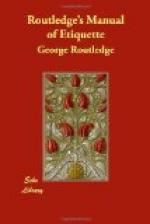2nd beat.—Spring on the right foot, bringing it up to where the left foot is, and raising the latter in front.
3rd beat.—Spring once more on right foot, passing left foot behind without touching the ground with it; this ends first bar.
2nd bar, 1st beat.—Slide left foot to the left, as before.
2nd beat.—Spring on right foot, as before, and bring it up to the place of left foot, raising latter at same moment.
3rd beat.—Fall on the left foot, and raise the right foot behind; end of second bar.
Begin third bar with right foot, and continue as before. You turn half round in the first three beats, and complete the circle in the second three.
* * * * *
XIII.—THE REDOWA, OR REDOVA.
The step of this valse somewhat resembles that of the Cellarius, and is used, as we have seen, in dancing the Mazourka Quadrille. It is an elegant valse, not so lively as the Polka Mazourka, but, if danced in correct time, not too slowly, is very graceful and pleasing. The step is not so difficult as that of the Cellarius; it is almost a Pas de Basque, with the addition of the hop. In all these dances, which partake of the nature of the Mazourka, it is requisite to mark distinctly the first and third beats of every bar, otherwise the peculiar character of the movement is completely lost. We describe the step for the lady as it is employed in the forward movement.
1st beat.—Stand with right foot slightly forward; spring upon it, bringing it behind left foot, which is raised at same moment.
2nd beat.—Slide your left foot forward, bending the knee.
3rd beat.—Bring your right foot, with a slight hop, up behind your left foot, raising the latter and keeping it in front. (One bar.)
1st beat.—Spring Upon your left foot, passing it behind your right, and raising latter.
2nd beat.—Slide right foot forward, bending the knee.
3rd beat.—Bring left foot up to right, with slight hop, and raise right foot at same moment, keeping it in front as before.
When the figure en tournant (circular movement) is employed, the lady begins by sliding the left foot forward, and the right foot backward. Gentleman always does the same, with order of feet reversed.
This dance has been very popular in Paris; in England it is now seldom seen.
* * * * *
XIV.—THE SCHOTTISCHE.
The Schottische was introduced amongst us about the same time as the Polka Mazourka, but it received a much more cordial welcome, and has always been popular in England. Its origin is as uncertain as that of the Polka, and it is believed to be a very ancient national dance. It is a great favourite with the German peasantry; and although its name, Schottische, would seem to imply that it came from Scotland, there is no doubt that it is essentially German alike in character and in music.




